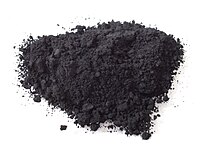
Photo from wikipedia
Abstract An improved polycyclic aromatic hydrocarbon (PAH) model is developed to predict the decomposition of indene and the formation of large PAHs under pyrolytic conditions. This model is developed based… Click to show full abstract
Abstract An improved polycyclic aromatic hydrocarbon (PAH) model is developed to predict the decomposition of indene and the formation of large PAHs under pyrolytic conditions. This model is developed based on experimental study of pyrolytic kinetics of indene in a flow reactor at low and atmospheric pressures (30 and 760 Torr) by using synchrotron vacuum ultraviolet photoionization mass spectrometry (SVUV-PIMS). A general map of PAH growth is presented according to the observations in this study and those in literature. Indene dissociates via indanyl forming mono-cyclic aromatics and small intermediates, while its dominant decomposition product is indenyl. As a resonantly stabilized radical, indenyl serves as a platform molecule in PAH growth process which links small unsaturated hydrocarbons and mono-aromatic species to multi-cyclic ones. Reactions of indenyl radical are proposed to form commonly studied and recently observed PAHs. Rate constants of these reactions are evaluated by analyzing literature data of rate constant measurements, quantum chemical calculations and analogy to cyclopentadienyl radical. The main PAH formation pathways are the bi-molecular addition reactions of indenyl radical with indene and a series of intermediates, forming C10 C18 and larger PAHs. Meanwhile, radical chain reactions provide huge passage for PAH growth form one resonantly stabilized radical (RSR) to larger ones. Particular contribution has been found from the reactions of RSRs that have five-member ring in their molecular structures, such as fluorenyl, benz-indenyl, cyclopenta-phenanthrenyl and benzo-fluorenyl.
Journal Title: Combustion and Flame
Year Published: 2019
Link to full text (if available)
Share on Social Media: Sign Up to like & get
recommendations!